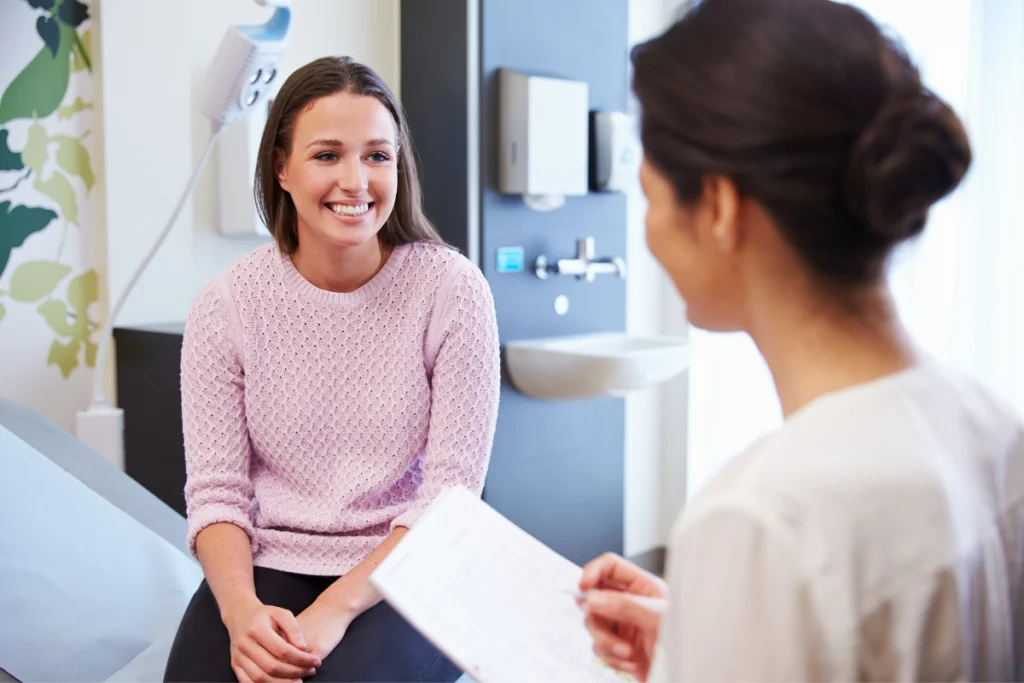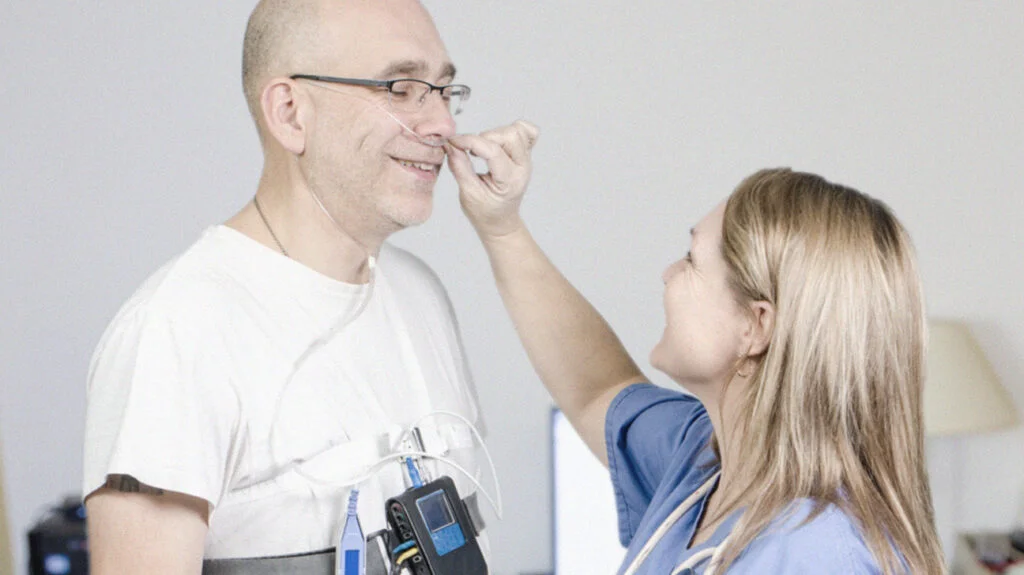Consultations for sleep apnea patients interested in oral sleep appliances
When you’re doing an oral sleep appliance consult for patients you want to be comprehensive and efficient. This means having good systems when following your workflows with the patients.
What to do before and after 1st and 2nd consultations

There are many ways to do this and you can vary your approach. In this blog post we’re going to present a few key parts to consider, and this can be modified to fit the needs of your practice.
The first consultation
First is to think about what are the pre-appointment tasks, what are the things you want to have ready before the patient shows up?
One is to have the front desk ask the patient: have they had a sleep study?
If so, we want to get a copy of that sleep study and have it in the patient record before the patient comes in. This has important information about the medical diagnosis and the severity of the sleep apnea that we can refer to.
Also, what is the medical insurance?

We’re often using medical insurance to bill for sleep apnea appliances. So can we get the medical insurance into the patient management software to have it ready in case the patient has questions about their benefits.
Also there are certain questionnaires that we could send to the patient before they come to the appointment to have this information ready to save time at the appointment.
Or the patient could come in a little earlier before the appointment, fill out some of the forms in the waiting room rather than just waiting in the chair to fill out this information.
Basic patient information form
One form may be the just basic patient information related to the sleep appliance.

Questions such as:
- how did they hear about the oral appliance?
- What are the chief complaints for which they’re seeking treatment?
- Who is their family doctor?
- Who is their sleep study doctor?
- Who is their family dentist?
Are they wearing a CPAP? And if they’ve had a CPAP but not wearing it, why not?
We should also ask some social history questions about their alcohol consumption, their sedative consumption, and caffeine consumption.
Also we can ask the questions like do they smoke? Do they use chewing tobacco? We also want to update any medical history in the notes.
You may also want to ask the patient to do a Berlin questionnaire sleep evaluation, just to get them thinking about questions such as:
How often do they snore.
Has their snoring bothered other people, and give them information to consider.
Then we may also give them a sleep health history form. The sleep health history form can cover things such as associated comorbidities like hypertension, history of high blood pressure, history of stroke, type two diabetes, heart disease, mood disorders, insomnia, and impaired cognition.
You can also ask them to fill out an Epworth Sleepiness scale evaluation. This series of questions can help to create an assessment of how tired they are doing certain activities like sitting, reading, or watching tv
Statement of therapy
You may also use a form, like a statement of therapy just to understand and create an opportunity for the patient to sign why they’re seeking and starting treatment.
Maybe they prefer to use an oral appliance over a CPAP, maybe they’re CPAP intolerant for various reasons, such as:

- mask leaks
- inability to get the mask to fit properly
- discomfort caused by the straps and headgear
- disturbed or interrupted sleep caused by the presence of the device
- noise from the device disturbing the patient’s sleep or the partner’s sleep.
- CPAP, restricting movements during the sleep.
- latex allergy
- claustrophobic associations
- unconscious need to remove the C PAP apparatus at night.

Or maybe they want to use the CPAP with the oral appliance, but having them specify their goals is important. All of these are good questions that you can ask before they come in.
Then when the patient has the appointment, of course there could be a form that the doctor fills out for medical records to document an oral appliance dental evaluation.
This exam should confirm that the patient has no active periodontal disease or dental decay.
And that the patient has no active temporomandibular joint disorder.
Also that the patient has no restriction in mandibular opening or protrusion.
The patient has sufficient detention to allow for the retention of the appliance and then we know the patient’s ready to proceed. We can also fill out some other information in the office.
We may want to just take some time to confirm some information like the patient’s chief complaint.
Why are you seeking treatment?
Is it because of the family doctor, the referring sleep doctor, the family dentist. Does the patient wear the CPAP? And if they have the CPAP, when do they start wearing it? Do they still wear it? We want to look at the AHI number or the RDI number and make sure we have all the documentation we need to confirm the medical diagnosis.
We may want to document the type of appliance we need, among the various kinds, which one we think is the most appropriate for the patients needs.
And we can also help prepare a letter to the referring physician, letting them know that we’re starting treatment. We should have that for good communication with the medical team. And also clinically, it’s important to do an airway evaluation taking steps to look at the tongue, the mallampati classification, the tonsils, the uvula, the gag reflex, and the nasal passages. Do they have season allergies or a history of a deviated septum.
Check the maxilla, mandible, and check the TMJ for joint sounds, range of motion, things like that that may affect the jaws.
Keep sleep physician updated
Afterwards, it is nice to send some correspondence to the referring sleep physician just to give them an update.
Maybe it just says that we reviewed the test results and other findings and discussed the risks and benefits and alternatives and limitations of oral appliance therapy.
Demonstration of the appliance was shown. In addition, we offered counseling on the etiology and consequences of sleep apnea.

We discussed the potential risks and complications related to treatment recommendations.
And we discussed the potential risk and consequences of sleep related breathing disorder if left untreated. And we discussed the alternatives for sleep related breathing disorders.
You could discuss if you had a treatment plan for a delivery of an appliance and to evaluate and titrate the oral appliance until comfort is achieved.
Other goals would be to reduce AHI, reduce snoring and daytime sleepiness. Let them know we discussed with the patient the mechanism of snoring and obstructive sleep apnea and reviewed the risks, limitations, benefits, fees, reasonable expectations of using a mandibular repositioning device.
And the patient would like to pursue this treatment with a mandibular repositioning device and will return soon for placement of the appliance.
So that can be a form that you can send to referring physicians just to let them know what the plan is and prepare all this information.
These were goals to achieve at the first visit.
The second consultation

Maybe have the patient come back for a second consultation after the first visit.
Do some benefits checks with the medical insurance if you need to do any preauthorizations or check benefits, whether you do that yourself or through a consultant’s help.
Get the records needed at the first visit and check the benefits. And then the patient comes back once the benefits are checked, and the information’s there. They can sign a consent form.
You can go through any payment arrangements, answer the patient’s questions.
The second consultation, you would also want to get some records of the teeth. You could do a model of the teeth.
If you have an intraoral scanner, that’s great too because if you have a scanner, you can have a digital record of the teeth and you can also print the models or send the digital file to the lab to make the appliance.
If you do an alginate impression, you may want to take some photos as well, just to have a record of how the teeth look. Just evaluate for any changes in the bite over time. But you can do the scan.
You can get a lab slip to order the appliance and schedule the patient to return in a couple weeks to pick up the appliance.
One other thing you may want to do before the second consult is if you have any other supporting information to send the patient in the mail or to give them that day. This gives the patient to learn more before starting the appliance.
You may be sending some follow-up letters to the doctor to let them know that you’re intending to start treatment.
But if you have a book you’ve written about oral appliances or any brochures, you could also send that to the patient to read over and look more and to the sleep apnea before their second consult.
You may also want them to try an app on their phone just to get experience using that before they get the appliance. So these are just some things that you can do to help the flow of the practice and to help efficiently treat patients with sleep apnea.


lasuna online buy – buy himcolin medication himcolin price
Very interesting topic, regards for posting.Raise blog range
gabapentin 600mg cheap – buy ibuprofen online cheap azulfidine 500mg pill
buy besifloxacin generic – buy cheap generic carbocysteine sildamax cost
benemid order online – oral probenecid 500 mg buy tegretol generic
celecoxib 200mg pill – buy flavoxate without a prescription purchase indomethacin pill
buy diclofenac sale – buy diclofenac 50mg buy aspirin 75mg online
buy mebeverine 135mg generic – order cilostazol for sale cilostazol 100mg oral
buy pyridostigmine pills for sale – sumatriptan 25mg cost cost imuran
rumalaya buy online – order shallaki generic cheap endep 50mg
cost lioresal – where to buy ozobax without a prescription order feldene 20 mg for sale
diclofenac over the counter – order diclofenac generic nimotop over the counter
periactin medication – buy cheap generic tizanidine buy generic zanaflex
meloxicam cheap – rizatriptan brand toradol 10mg uk
buy generic cefdinir for sale – buy clindamycin sale buy generic cleocin
how to buy artane – purchase voltaren gel cheap voltaren gel online buy
accutane 20mg pills – isotretinoin 10mg ca cost deltasone
order acticin – how to get benzoyl peroxide without a prescription order retin cream without prescription
buy generic betnovate 20gm – brand betamethasone buy benoquin
buy metronidazole 400mg pill – buy metronidazole cheap buy cheap generic cenforce
amoxiclav cheap – order augmentin generic levothyroxine brand
buy cozaar without prescription – purchase hyzaar online order generic keflex 500mg
buy cleocin 300mg online – buy cheap clindamycin cost indomethacin 75mg
buy generic modafinil – buy phenergan generic melatonin 3 mg ca
how to buy crotamiton – eurax cream aczone cheap
order zyban online – buy orlistat sale shuddha guggulu oral
capecitabine cost – xeloda 500mg usa order danocrine 100mg online cheap
prometrium 200mg us – purchase clomiphene pill buy fertomid generic
alendronate 35mg price – order medroxyprogesterone cost medroxyprogesterone
norethindrone 5mg canada – careprost allergy spray yasmin cost
estrace 2mg brand – estradiol 1mg pill order arimidex 1 mg pills
18 Testicular cancer represents 1 priligy seratonin
гѓ—гѓ¬гѓ‰гѓ‹гѓі е‰ЇдЅњз”Ё – г‚ўгѓўг‚シシリンジェネリック йЂљиІ© г‚ёг‚№гѓгѓћгѓѓг‚ЇгЃ®йЈІгЃїж–№гЃЁеЉ№жћњ
バイアグラ жµ·е¤–йЂљиІ© – жЈи¦Џе“Ѓгѓђг‚¤г‚ўг‚°гѓ©йЊ гЃ®жЈгЃ—い処方 г‚·г‚ўгѓЄг‚№гЃ®иіје…Ґ